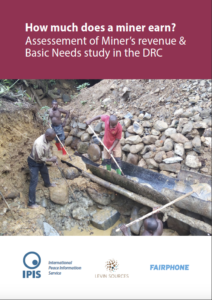How much does a miner earn in Democratic Republic of the Congo (DRC)? Can a miner’s family cover its basic needs? In a new report, IPIS and Levin Sources compare the income of miners and their basic needs expenditures, to provide a better and nuanced understanding of why ASM communities seem to remain extremely poor and identify the factors that impact their income. This report is the first to find that in Eastern Congo, miners’ families have a difficult time making ends meet, even though artisanal and small-scale mining (ASM) is among the best income sources available to many. To improve miners’ revenues, downstream users of minerals such as tin, which is still mostly mined artisanally, should first and foremost remain engaged in ASM supply chains and continue to purchase minerals in line with due diligence guidelines.
In Eastern Congo, a couple, typically parents sustaining a household of six members, working full-time in artisanal mining can earn around US$ 202 per month, but with four dependents, they would need around US$ 243 to cover the expenditures for the basic needs of the family.
Still, ASM is one of the best sources of income in Eastern DRC, especially for populations with limited education or qualifications, who do not own land or other assets. Miners seem to be significantly better off than other populations in DRC, where 73% of the population live below 1.90 USD per day. In comparison, miners can make 2.7 – 3.3 USD per day.
Key factors influencing the revenue of miners seem to consist of both technical/physical and social aspects. The technical/physical aspects include the productivity of the mine and hence opportunities to access finance and credit, the accessibility or remoteness of the mine site, and of course changes between seasons and world market prices. The social aspects influencing revenues include gender, the presence of cooperatives, the way revenues are distributed amongst the mine workforce, and thus the socio-economic organisation of the mining operation.
To improve miners’ revenues, downstream users of minerals should first and foremost remain engaged in ASM supply chains and continue to purchase minerals in line with due diligence guidelines. In addition, they may want to take action and collaborate with other supply chain stakeholders to positively influence the above-mentioned factors. Artisanal miners do not see the benefit of selling their mineral to the legal supply chain, therefore all stakeholders of the supply chain should look for incentives to convince miners to stay in the formalised and legal trade chain.
Press release by IPIS, Levin Sources and Fairphone
Read Fairphone’s blogpost ” How much does a miner earn ? “
Listen to Fairphone’s podcast featuring Guillaume de Brier (IPIS) and Angela Jorns (Levin Sources)


